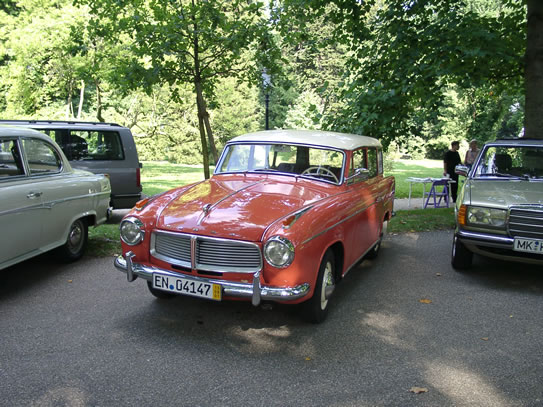Description
The Hansa 1100 Combi was the estate, or station wagon, version of the Hansa 1100 series, produced by the Borgward Group during the mid-1950s. It was designed to offer the practicality of a family or utility vehicle while retaining the refined engineering and styling of the Hansa saloon. At a time when small estate cars were becoming increasingly popular in postwar Europe, the 1100 Combi provided an ideal blend of versatility, comfort, and understated elegance.
The exterior design of the Hansa 1100 Combi followed the same rounded and harmonious lines as the rest of the 1100 range. The front featured the familiar horizontal grille with twin round headlamps and subtle chrome detailing, giving the car a clean, modern look. From the side, the Combi’s extended roofline and large rear windows provided a balanced, practical profile. The rear section was squared off slightly to maximize cargo space, but Borgward’s designers managed to retain the car’s cohesive and graceful proportions. It looked purposeful but never utilitarian—a stylish estate in miniature form.
Inside, the Combi offered greater space and flexibility than the coupé or saloon. The rear seats could be folded down to create a flat loading area, making it suitable for carrying luggage, tools, or small business deliveries. The cabin was simple but well finished, with durable materials chosen for comfort and longevity. The dashboard mirrored that of the saloon model—functional, clearly laid out, and lightly accented with chrome or painted trim. Seating comfort was good for a car of its class, and visibility was excellent thanks to the large glass area, making the 1100 Combi practical for both city and country use.
Mechanically, the Hansa 1100 Combi was powered by the same 1,097 cc inline four-cylinder engine as the rest of the range. Producing around 40 horsepower, it was paired with a four-speed manual gearbox driving the rear wheels. The car’s performance was modest, with a top speed of about 115–120 km/h (71–75 mph), but its engine was smooth, economical, and reliable—traits that mattered more to the car’s intended buyers. Its light weight and well-tuned suspension gave it stable and predictable handling, making it easy to drive even when loaded.
On the road, the 1100 Combi delivered a pleasant driving experience. While not designed for speed, it was comfortable, steady, and well balanced. Its compact dimensions made it agile in town, while its spacious rear compartment made it ideal for families, tradesmen, or even small business owners who needed a versatile yet refined vehicle. In this sense, it served a similar role in Germany to cars like the Morris Minor Traveller in Britain or the Peugeot 203 Familiale in France.
Production numbers for the Hansa 1100 Combi were relatively low compared to the saloon models, as estate cars were still a niche market segment in the 1950s. However, it played an important role in showcasing Borgward’s attention to practicality and design detail, bridging the gap between commercial utility and passenger comfort.
Today, the Hansa 1100 Combi is a rare and charming survivor of its era. Its combination of thoughtful design, mechanical simplicity, and elegant proportions make it a prized collectible among enthusiasts of postwar German automobiles. It represents a time when even utilitarian cars were crafted with care and a sense of style—a modest yet graceful expression of the optimism and ingenuity that characterized the rebirth of the European car industry in the 1950s.
